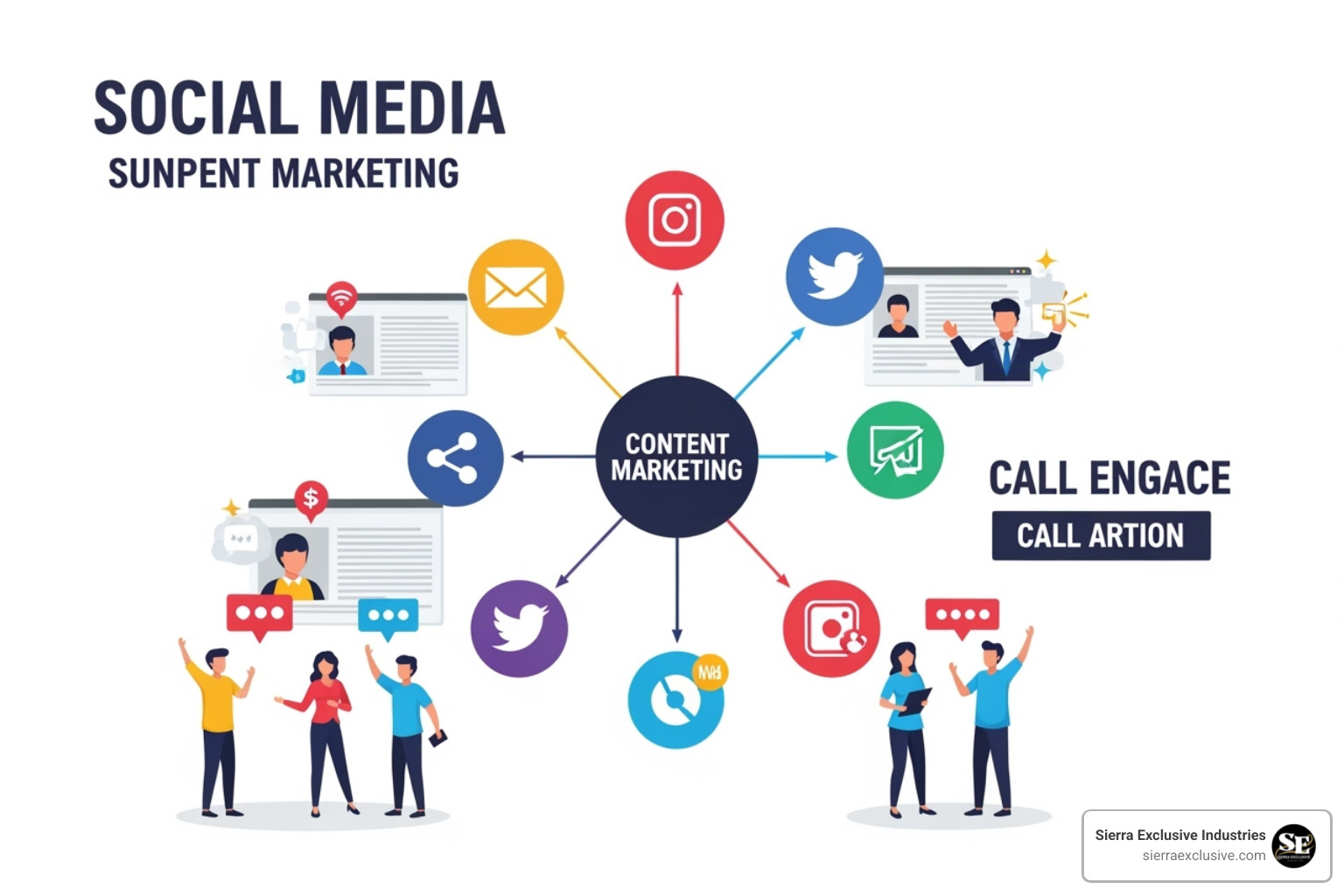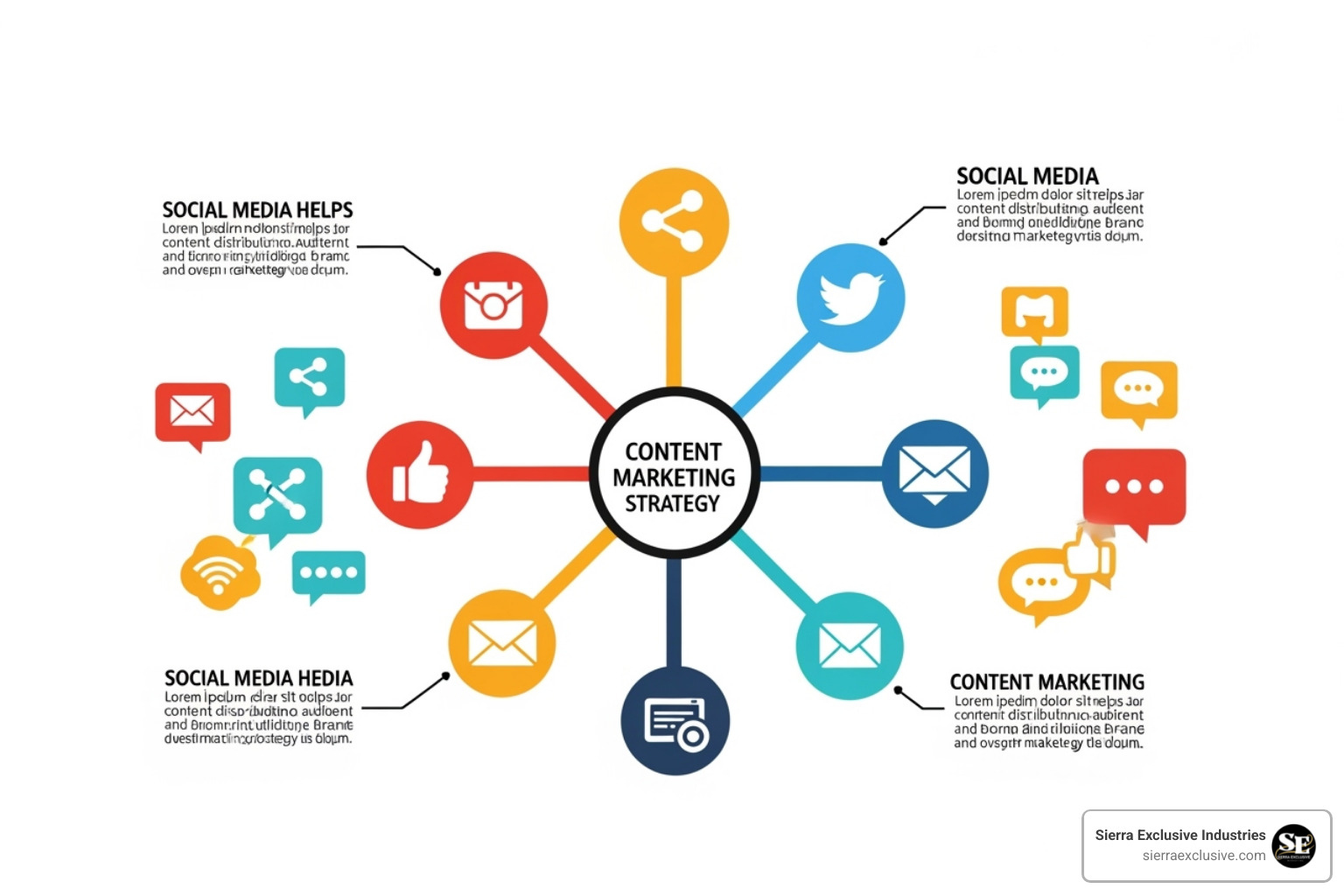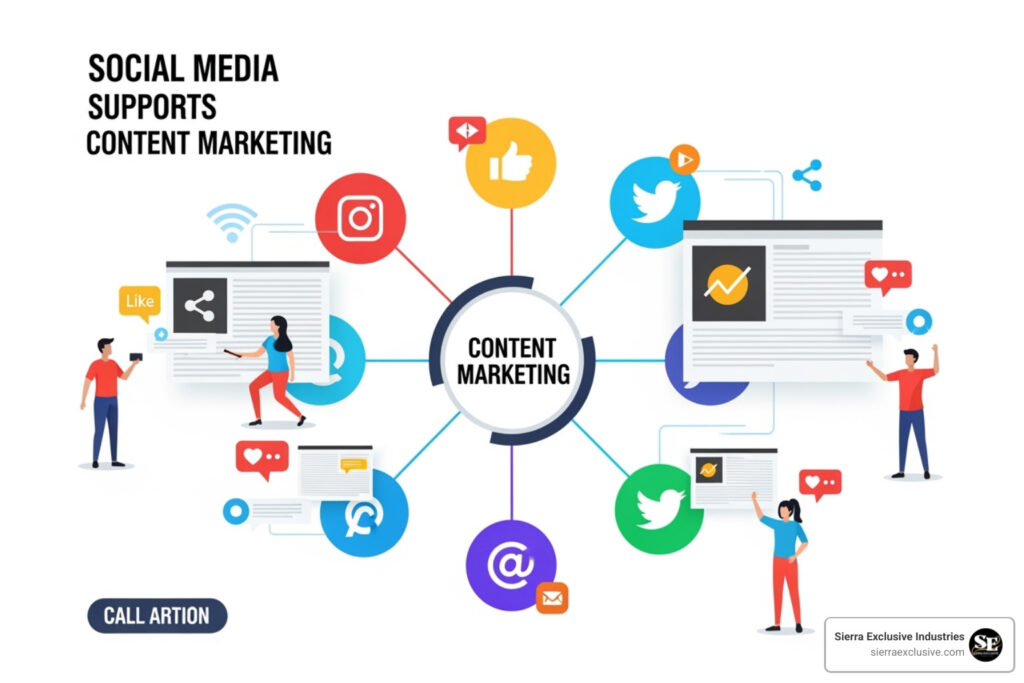Why Social Media Is Your Content Marketing’s Secret Weapon
How does social media support content marketing? It acts as a distribution powerhouse and an engagement catalyst for your content.
Here’s how social media supports content marketing:
- Amplifies reach – Distributes content to 4.89 billion social media users worldwide
- Builds community – Creates two-way conversations around your brand
- Generates ideas – Provides endless content inspiration through social listening
- Drives traffic – Sends qualified visitors to your website and landing pages
- Enables targeting – Reaches specific audiences with precision advertising
- Measures impact – Tracks engagement, conversions, and ROI in real-time
Successful brands, like content expert Jay Shetty, treat social media and content marketing as two sides of the same coin, creating a unified strategy that builds trust and revenue.
The synergy is undeniable: content needs distribution, and social media needs valuable content to share. When aligned properly, this partnership can generate impressive results like Myfix Cycle’s 1,529% return on ad spend through strategic retargeting campaigns.
I’m Seth Gillen. Having built multiple companies to $10M+ revenue and scaled Sierra Exclusive Marketing, I’ve seen how understanding how does social media support content marketing can transform businesses into market leaders.

How does social media support content marketing terms to remember:
The Foundation: Why Social Media and Content Marketing Are a Power Couple
Social media and content marketing are interdependent. Content educates your audience, while social media shares that message. Working in harmony, they create a formidable marketing engine.
Building Brand Authority and Trust
In the digital world, trust is currency. Social media helps build it through consistent, valuable content and authentic interaction. By sharing insightful articles, guides, and expert opinions, you establish your brand as a thought leader and a go-to resource.
Answering questions and addressing pain points builds credibility and demonstrates genuine expertise. Since 81 percent of consumers need to trust a brand before buying, social media is a powerful tool for changing a brand monologue into a dialogue, making it relatable and building enduring connections.
Expanding Your Reach to Billions
With 4.89 billion users worldwide, social media offers an audience of unprecedented size. This massive reach means your content can be seen by millions, far beyond your immediate network.
When content resonates, users share it, amplifying your message exponentially. This viral potential helps a well-crafted post or video reach new markets organically. A robust Social Media Marketing strategy ensures your content actively reaches and engages its target audience.
Driving High-Quality Traffic and Leads
Social media is an effective driver of high-quality traffic to your website. Every piece of content can include a clear call-to-action (CTA) directing users to learn more, download a resource, or make a purchase.
For instance, 50 percent of Instagram users visit a brand’s website after seeing Stories. This shows active engagement. By strategically placing links and CTAs, you can guide prospects down the marketing funnel. Social media acts as a bridge, converting casual browsers into engaged leads. This transition is vital for Traffic Conversion Optimization and turning interest into action.
how does social media support content marketing
Social media transforms static content into living conversations that build genuine connections. It’s more than a megaphone; it’s a dynamic ecosystem where your content sparks discussions, gets shared, and builds lasting relationships that turn followers into loyal customers.
Fueling Your Content Engine: Using Social Media for Ideation and UGC
How does social media support content marketing when generating ideas? It’s not just for broadcasting; it’s for listening. Think of it as a direct hotline to your audience’s needs. Every comment and conversation is a goldmine for inspiration, providing real-time feedback on what your audience cares about.

Tapping into the Conversation for Endless Content Ideas
Social listening reveals your audience’s pain points. By monitoring hashtags, brand mentions, and relevant discussions, you get a real-time pulse on what matters most to them.
If the same question pops up repeatedly, that’s a content opportunity. Common problems, feature questions, or confusing terminology can all become the basis for a new blog post, video, or infographic.
Social listening tools help identify trending topics early, positioning you as a thought leader. This proactive approach ensures your content is timely and relevant. Creating content based on actual demand, not guesswork, is a data-driven strategy that optimizes our Blog for maximum impact.
How social media supports content marketing with user-generated content (UGC)
User-generated content (UGC) turns customers into your content creation team. When real customers share photos, testimonials, or videos of their experiences, they provide authentic social proof that is more convincing than traditional marketing copy.
For example, National Geographic’s 180 million followers contribute photography, turning their audience into active participants. This creates a powerful cycle: customers feel valued, and the brand gets a stream of authentic material.
The magic of UGC is its authenticity. Seeing real people enjoy your products builds trust far more effectively than traditional ads. These testimonials are powerful content pieces that can be repurposed across platforms.
Contests and hashtag campaigns are great ways to generate UGC. Asking customers to share their stories or creative product uses provides content while building a stronger community.
Running Polls and Surveys for Direct Feedback
Sometimes, the best way to know what your audience wants is to ask. Instagram Stories polls, Twitter surveys, and Facebook questions give you immediate access to their preferences and opinions.
Before creating a long-form piece, test the waters with a poll. Let your audience vote on potential topics to ensure you’re creating content they genuinely want.
These features also make your audience feel heard and valued. When people participate in polls, they become more invested in the final content and are more likely to engage with it.
Polls can also reveal preferences for format, timing, and style, helping you refine your strategy. This feedback loop is invaluable for co-creating content, turning followers into collaborators in your content journey.
From Strategy to ROI: Aligning, Repurposing, and Measuring Your Efforts
The magic happens when social media and content marketing are treated as one integrated system. How does social media support content marketing becomes clear when you align your brand voice, repurpose content smartly, and measure what matters for business growth.

Aligning Your Brand Voice and Visuals
Think of your favorite brand; you likely recognize their content instantly. That’s brand consistency. Aligning your brand voice and visuals across all platforms creates a cohesive experience that builds trust. Your tone should be consistent, from blog posts to social media responses.
Visual elements like color palette, logo, and fonts are equally important for creating an instantly recognizable presence. This isn’t just about aesthetics; it’s about building a brand that makes people feel confident in choosing you. Consistency reinforces your message and strengthens audience connection.
Repurposing Content for Maximum Impact
Repurposing is where efficiency shines. Instead of creating ten new pieces of content, transform one great piece into ten different formats. This is how social media supports content marketing by giving you multiple ways to share the same valuable message.
A blog post can become an explainer video for Reels or TikTok. Key points can become quote graphics. An infographic can be broken into a carousel post, and a podcast can become an audiogram. Each format reaches different audience segments based on their content consumption preferences.
Repurposing maximizes your content’s value while saving time and resources. It’s about strategically amplifying your best ideas across multiple channels instead of constantly creating from scratch.
Boosting Content with Targeted Ads and Retargeting
Organic reach is great, but targeted advertising and retargeting are secret weapons for giving content an extra push. Platforms like Facebook Ads and LinkedIn Ads let you serve content directly to your ideal customer by targeting specific demographics, interests, and behaviors.
Retargeting is especially powerful. When a website visitor leaves without converting, you can show them personalized content ads on their social feeds, nurturing warm leads by staying top-of-mind.
The results can be incredible. Myfix Cycle achieved a 1,529% ROAS with strategic retargeting, proving the power of this approach, which we detail in our guide on Why Facebook Marketing Trends Still Drive Business Growth in 2025.
Key Metrics to Measure Your Success
Vanity metrics like followers and likes don’t pay the bills. What matters is whether your strategy drives business results. Focus on actionable metrics like engagement rate, click-through rate (CTR), and conversion rate to get the real story.
Track website traffic from social media, Cost Per Lead (CPL), and Return On Ad Spend (ROAS). The key is connecting social activity to business outcomes like leads and sales. This data-driven approach, fundamental to our The Art of Social Campaign Management services, turns engagement into measurable results.
Frequently Asked Questions about Integrating Social Media and Content Marketing
How do I choose the right social media platforms for my content?
Don’t try to be everywhere. Focus on the platforms where your audience is active. Start with demographics: LinkedIn is great for professionals, while TikTok and Instagram are key for reaching Gen Z. Understanding audience behavior is crucial, and social media demographics can guide your decisions.
Next, consider your content format suitability. Match your content format to the platform: visuals for Instagram, professional insights for LinkedIn, and short videos for TikTok/Reels. Your B2B vs. B2C focus also matters; B2B often succeeds on LinkedIn and Twitter, while B2C thrives on more visual platforms like Instagram and Facebook. Finally, analyze your competitor presence to understand the landscape and find your unique angle.
How can I effectively repurpose one piece of content for multiple platforms?
Repurposing isn’t just copy-pasting; it’s about adapting content to each platform’s unique personality. Start by identifying your core message. Then, extract the key points like statistics, quotes, or tips that can stand alone.
Next, adapt the format: a blog post can become an Instagram carousel, a TikTok tutorial, Twitter quotes, or a LinkedIn infographic. Tailor captions and hashtags for each platform’s tone—professional for LinkedIn, casual for Instagram. Finally, schedule strategically over days or weeks to maximize reach without overwhelming your audience. Our Content Promotion Planning Made Easy guide can help you create a system.
What are the most important metrics for measuring the ROI of my integrated strategy?
Forget vanity metrics. To measure how does social media support content marketing, focus on metrics tied to your bottom line.
Focus on metrics tied to business goals first. If your goal is lead generation, track leads from social media. If it’s sales, measure revenue from social traffic.
Key metrics include:
- Conversion Rates: How many social visitors take a valuable action on your site (e.g., download, sign up, purchase)?
- Lead Quality: Are leads from certain platforms better than others? This helps you allocate your budget effectively.
- Customer Acquisition Cost (CAC): How much does it cost to acquire a customer through social channels?
- Return on Ad Spend (ROAS): For paid campaigns, are you earning more than you’re spending?
The goal isn’t to track everything—it’s to track what matters for your specific business goals.
Conclusion
Integrating social media and content marketing is a powerful driver of business change. As we’ve seen, social media amplifies content, builds communities, and creates engagement that drives real results. The key is to stop treating them as separate tasks and view them as a single, integrated strategy. Content gives social media value, and social media gives content a stage to connect with an audience.
Social media transforms content distribution into a targeted, measurable system. By leveraging user-generated content, social listening, and smart repurposing, the opportunities to connect are endless.
Measurement is crucial. Tracking key metrics like conversion rates and ROAS reveals the direct impact on your bottom line. Remember Myfix Cycle’s impressive 1,529% ROAS? That’s a testament to what’s possible with a strategic, aligned approach.
Implementing these strategies builds a sustainable growth engine. Your brand becomes more trustworthy, your reach expands, and customer relationships deepen. Ready to see these results? Sierra Exclusive Marketing specializes in creating powerful, integrated strategies with an AI-powered approach. We guarantee results—or you don’t pay. Explore our Social Media Marketing services to transform your marketing into a cohesive, revenue-generating machine.




